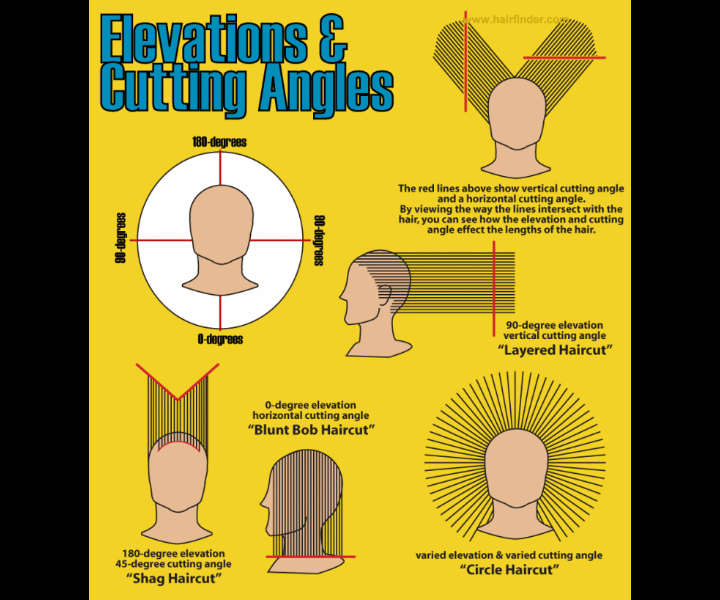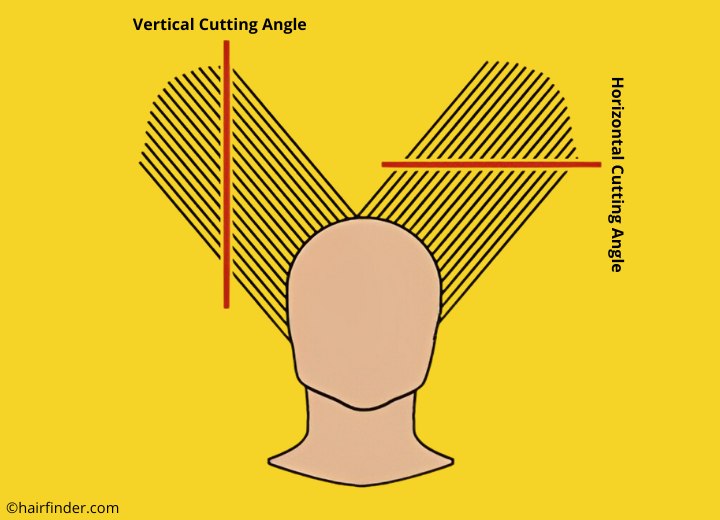Haircutting Tips: Angles and Elevation

I was asked by a cosmetology student to help him with a subject that he found very confusing when he talked with others about cutting hair: Elevation and angles.
He wasn’t alone. I’d been asked similar questions by lots of different people who were cutting hair either as amateurs cutting family member’s hair, or new students who seemed confused by things that they had read.
This is what they mean and how they work:
Elevation
With everything in our world, gravity has its pull. If you hold a piece of string it will hang down, the end pointing toward the ground. Even if you hold the string so that it emerges from between your fingers and starts pointing upward, the length and weight of the string will cause the end to point down.
Hair behaves the same way - more or less. Depending on the texture, length, and wave pattern of the hair, it will ultimately find its way to having the ends point downward. For some hair types, particularly coarse and kinky hair types, this might require a great deal more length than the hair can achieve.

It is because of this gravitational pull that we use elevation as a facet of cutting hair. The degrees of elevation are constant, regardless of the position of the hair on the head. The Elevation points are simple: Zero degrees of elevation is hanging so that the ends point to the floor; ninety degree of elevation means the hair is held so that ends are pointing to the side, parallel to the floor; and 180-degree elevation means the hair is held straight up pointing toward the ceiling.
So, a hair, whether it is growing on the center of the top of your head or on the side of your head in front of the ear, when allowed to hang down so that its end points to the floor, is considered to be at zero elevation. Subsequently, anytime the hair is combed out and held to point to the sides, parallel to the floor, it is said to be held at ninety degrees of elevation, and any hair that is held so that the ends point straight up overhead, regardless of its point of origin, is said to be held at 180-degree elevation.
Angles
The other facet of haircutting that many people get confused over is Angle, and when a stylist speaks about angle in haircutting, he or she is referring to the position of the scissors in his or her hand in relation to something else, usually the floor.
For some people these concepts come naturally. They can look at a haircut and “see” the positioning, angles, and elevations needed to create the cut. For others, it takes more time to learn how these different positions interact and affect the outcome of the cut.

The angles used in cutting the hair are going to vary widely from style to style and even from hair type to hair type. Because of this, there is no real reason to try and complicate matters needlessly. Unless otherwise specified in the cutting instructions, when it says "the hair is cut at X-degree angle", it means that the scissors are held at an angle of x-degrees in relation to the line of the floor. For example a 45-degree cutting angle would mean holding the scissors halfway between completely horizontal (parallel to the floor) and completely vertical (perpendicular to the floor).
The use of angles and elevation help a stylist create a variety of looks. Generally speaking, the lower the elevation and the more horizontal the cutting angle, the less layered and more blunt the cut will be. Increasing either or both the cutting angle and elevation will increase the amount of layering in the hair.
For example: the classic blunt bob is cut with the hair at zero degrees of elevation and using a horizontal cutting angle; and the long-layered "shag" haircut is created by holding the hair at 180-degrees elevation and using a 45-degree cutting angle to create shorter-to-longer layers from the center of the head to the outside. Every other style and cut out there is simply a variation on the theme created by combining angles and elevation in different ways at different points around the head.
©Hairfinder.com
See also:
Haircutting templates to plan out a haircut
How do you cut an angle cut in the front?
Is there a certain angle I need to focus on when cutting hair?
How to hold your scissors when cutting hair